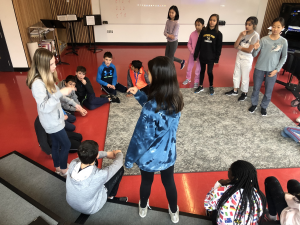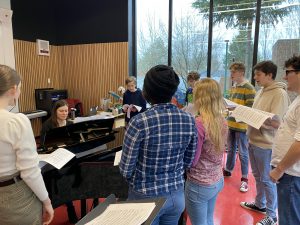(1) coaches and reinforces peer-to-peer dynamics that are appropriate and constructive
(2) communicates behavioral expectations that are appropriate to class activities
(3) develops a mutually respectful relationship with each student, instilling confidence that the teacher is invested in their success
(4) demonstrates cultural competence by promoting inclusivity
(5) designs and facilitates a classroom culture that promotes student preparedness, engagement, self-advocacy, perseverance, and collaboration
My classroom culture is centered around teambuilding, process, and feedback. Because the majority of my classes are ensemble and performance based, developing the identity of a team is crucial to our success. The students need to know and trust each other. The students need to trust in my leadership. Through building this culture, we create a sense that our work is successful and at the same time we continue to seek improvement through critical listening and giving and receiving feedback.
First, we play. Games allow trust to be established, offer an opportunity to set expectations for behavior and communication (1,2),  . At the beginning of the trimester as a part of establishing norms, I directly instruct the class on my expectations for positive and uplifting interactions. Over the next several classes we spend quite a bit of time playing games that range from ice-breakers, to theater and musicianship games. The games help to build ensemble and they also give me time to watch the students interact with each other, reinforcing appropriate behavior and discouraging the opposite (2). Through games we learn content and routine, such as how the voice works and warming up. Equally important, students learn to trust each other, and I learn who they are, how they interact, their willingness to take risks and the level of basic music competency.
. At the beginning of the trimester as a part of establishing norms, I directly instruct the class on my expectations for positive and uplifting interactions. Over the next several classes we spend quite a bit of time playing games that range from ice-breakers, to theater and musicianship games. The games help to build ensemble and they also give me time to watch the students interact with each other, reinforcing appropriate behavior and discouraging the opposite (2). Through games we learn content and routine, such as how the voice works and warming up. Equally important, students learn to trust each other, and I learn who they are, how they interact, their willingness to take risks and the level of basic music competency.
“While a lot of this was playful, students are using their voices as instruments and playing around with them. If we think of culture as the rules that guide behavior, in the background, often without frequent or explicit reference to them, you’re using culture to do a lot of work in this class. AND, it’s directly tied to content – rhythm, range, embouchure (can that apply to the mouth?) and all sorts of stuff. Really cool.” Dr Stegeman observation, 5-6th grade choir 2/3/20
By promoting play as a value in class (Ped-3) we create a culture of openness and inclusivity; that we each arrive every day with musical capacity as humans, but learned behavior, or history, as well. That history may be star-studded and come with a long resume of private lessons and stage time, or it may be heavy and loaded with anything from performance anxiety to body image issues. Yet still, each person is a member of our team for that trimester, and establishing trust allows for risk taking and honest feedback channels to exist (Ped-7).
“After agreeing on an arrangement and talking though it Ginger said, “Ok, let’s try it. This might be a disaster, bu t let’s try it!” A good example of the willingness in this class to try new things, to fail, adjust, and try again. After the group tried the arrangement, the students discussed what worked and what didn’t. The group did a nice job of providing critical feedback in a positive way.” Mr Hagen observation, US Choir 1/31/20
t let’s try it!” A good example of the willingness in this class to try new things, to fail, adjust, and try again. After the group tried the arrangement, the students discussed what worked and what didn’t. The group did a nice job of providing critical feedback in a positive way.” Mr Hagen observation, US Choir 1/31/20
Because of the flexible content of the course and the nature of teamwork, there is much opportunity to practice inclusivity (4). Everything we do in class, and in life, will be experienced differently by different people, but in order for us to be our best and take risks, we have to operate as a team and be inclusive of everyone’s place in the class. I try to practice inclusivity through accepting the humans that walk through the door. I listen to them, and I believe them. Regarding content, taking advantage of the ubiquitous nature of vocal music allows us to travel across the world and throughout time to sing pilgrimage chants from Medieval Spain (Gaudete Rel-6), wedding songs from the Zulu people of South Africa (Rel-8) and Bollywood music in Hindi (Rel-7). Other examples of how I approach inclusivity in terms of gender, religion, skill, and language can be found in the Relational Cultivation section.
Our class experience follows an arc that, a few weeks into the term, requires us to turn away from teambuilding games and towards repertoire. The work feels more like work. Listening critically and giving feedback to inspire growth becomes a focus. Because we work toward a public performance, it is rare that I have to do much external motivation towards preparedness, engagement, self-advocacy, perseverance, and collaboration. It is baked into everything we do so that the students have ownership in their work toward performance (3,5).
“As in the U.S. Choir class I observed, these students were clearly operating in a classroom environment in which expectations of engagement, respect, and preparedness had been instilled. And again, Ginger reinforced those expectations throughout, in a Middle School-appropriate way—the pace was rapid enough to keep students on task and interested, but slow enough so that they understood what was being asked of them.” Dr. Olsen, 5-6th grade choir, 1/28/20
In an early observation (Ped-2), Dr. Olsen attended a class that had been increasingly interrupted by students playing a non-verbal hand sign game. In order to refocus them, I called on our shared goal of a successful concert, and reminded the students of how much work they had put in to their preparations. My time on the sports court has been limited in a life spent in long rehearsals, but I imagine that this pep talk went something similar to any team that needs a reminder of their duty to each other and to their larger goal: Think about how hard you have worked, you deserve to have a successful concert, your peers deserve your best work as does the audience, and the art. Don’t let distraction rob you of that opportunity. The concert will be here soon whether or not you’re ready. By using the concert as an end-date for the team product, I am drawing them in to the process of preparing for something bigger than themselves which requires teamwork and focused preparation.
Another example of collaboration and feedback outside of our classroom is the Winter Concert 2020.
My MS Choir of 23 fifth and sixth graders visited Dr. Castro’s Instrumental Music Ensemble. In preparation for this visit, we had a big discussion about rehearsal etiquette and how to give feedback. In the context of this first rehearsal, IME had only recently received their music so had limited time rehearsing, while choir had listened to the original many times. I was trying to prepare them for the reality that their peers in IME would not sound like Stevie Wonder’s band, just like they do not sound like Stevie singing. We discussed the learning process, and how to give honest feedback that is motivating for improvement. I asked for examples of what would be inappropriate feedback, and they had a lot of fun coming up with ideas. Then, we shared examples honest and appropriate feedback that recognized that there is a lot of work to be done before the song is ready to be performed. Feedback is central to what we do because it is the vehicle to improving, and communicating feedback appropriately is necessary for growth (Ped-16).
An area of improvement that I would like to focus on in future practice, which has been greatly sped along by the nature of distance learning, is individual feedback. In reading the survey responses to our unique F&PA course evaluation question to “describe your experience giving and getting feedback” it became clear to me that this work is largely implicit in the class ensemble process, and less explicit for individuals. Teaching online, a format in which it is not possible to rehearse ensemble music, has required me to design a student experience based on individual work which is submitted via recordings. This gives me the opportunity to comment specifically on individual vocal technique as well as giving the students more choice in the material that they are learning. If something is very awry in an typical rehearsal, I will kindly coach that student away from bad technique, but I often bring the class with me as we explore how to do it. There is learning to be had for everyone. I usually meet with the students twice a term individually to review their progress and vocal health and I am able to give them specific verbal feedback in those settings. As I have studied my practice through the lens of this PDP as we transitioned modes of learning, I realize the value in carving out more opportunities for specific individual feedback that is not always possible in an ensemble setting. I will maintain and build upon the opportunities for individual feedback practices I currently have if and when we are able to resume in-person school.
Earlier in my career I did not see the value in play as clearly as I do now. Transitioning from semi-pro ensembles to the middle and upper school classrooms of a young school meant that my expectations were higher than students were prepared to meet. Younger, disciplined musician Ellingson had not appreciated that building ensemble took intention and time. I thought games were silly and I was a serious musician.
However, over time I have learned more of what students need in order to feel a sense of membership in the class. I have adjusted to allow for more and more time to be spent building relationships and culture, and they do make the music better, through a less formal rehearsal method. By establishing a culture of teamwork, we practice inclusivity, and strive for improvement through process oriented feedback and a shared goal of the concert.